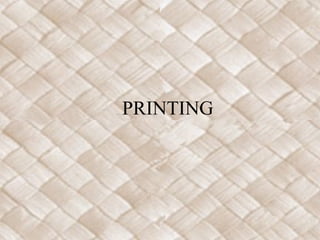
Printing
- 1. PRINTING
- 2. `OHE KĀ PALA • `Ohe – bamboo • Kāpala – stamp • Sacred bamboo grove – Hōmaika`ohe – in Pu`u Hāla`i in Hilo that was planted by Hina (mother of Māui)
- 3. OLI Ma uka, ma uka ka ua There’s rain in the uplands Ma kai, ma kai ka ua And down in the sea Ho`olei ho`olei ka ua i Pohākea The rain slashes at Pohākea Hō mai i `ohe Grant me bamboo I `ohe aha What for I `ohe `oki`oki ua Bamboo to cut (stop) the rain
- 4. `OHE KĀ PALA
- 5. `OHE KĀ PALA
- 6. If you have any questions, please ask them on the Discussion Board. Mahalo!
Notas do Editor
- `Ohe is a canoe plant. Hawaiian bamboo has thinner walls than the more recently introduced and now more common Chinese bamboo. `Ohe maoli (Hawaiian bamboo) has longer nodes, green, real thin walls. `Ohe haole/kahiki (foreign bamboo) has shorter nodes, larger tubes, thicker walls. Symbolism of `ohe - `ohe is used for protection. It was used as a pale (shield) – sort of like a good luck charm when traveling (lā`ī, salt, nīoi). Symbolism is to cut – meaning that it cuts negative energy or it’ll cut anything bad that will come near you. Legend says that Hina, a widely known goddess or demigoddess throughout Polynesia, was in one legend the wife of Akalana and the mother of the demigod Māui. She is said to have brought the `ohe with her from Kahiki and planted it beside her door. When Māui saw the plant, he reached for it. The sharp stem of the bamboo cut his hand. Hina, who was a powerful goddess, then turned the stem inside out. Now the sharp part of the bamboo is inside the stem an the outside is smooth and round.
- Designs were carved in a variety of geometric patterns were used for a form of block printing.
- The stamp was dipped into a container of liquid dye. Excess was removed by tapping the stamp against the rim of the dye bowl. The carved end bearing the film of dye was pressed against the kapa and the process was repeated until a continuous line or an intricate pattern had been stamped onto the kapa.